Numerical Simulations of the Seismic Response of a RC Structure Resting on Liquefiable Soil
Abstract
:1. Introduction
- Simulating the real structure of the building to facilitate better insight into liquefaction effects on the response of the building.
- Considering a wide range of scenarios by performing numerical analyses with different earthquake records.
- Studying the role of the thickness of the liquefiable layer combined with the relative density of sand on the settlement and lateral displacement of the building.
2. Numerical Model
3. Earthquake Records
4. Soil Properties
5. Results
5.1. Seismic Settlement
5.2. Lateral Displacement
6. Conclusions
- The trend in the relationship between the liquefaction-induced settlement and the PGA achieved a slightly higher coefficient of determination when compared with that resulting from the relationship between the settlement and CAV. Hence, PGA is suggested to be applied to measure the earthquake intensity with liquefaction-induced settlement.
- In particular, the liquefaction-induced settlement and liquefaction-induced lateral displacement of the building increase as PGA increases. However, there are some fluctuations in the increase that are due to the effect of the predominant frequency of the seismic shake.
- The liquefaction-induced settlement slightly changes as the soil density changes from loose to medium. Thus, there are some cases of decreasing and increasing settlement when the density of the liquefiable layer changes from loose to medium. However, the dense liquefiable soil produces lower seismic settlement compared to the cases for loose and medium liquefiable ground.
- On average, increasing the density of the liquefiable soil from loose to medium does not perceptibly impact the development of the liquefaction-induced lateral displacement. However, liquefaction-induced lateral displacement is generally reduced in case of an RC structure resting on dense sand.
- The lateral displacement of the building is not generally sensitive to the increase in the thickness of the liquefiable layer.
Author Contributions
Funding
Data Availability Statement
Conflicts of Interest
References
- Dashti, S.; Bray, J.D.; Pestana, J.M.; Riemer, M.; Wilson, D. Mechanisms of seismically induced settlement of buildings with shallow foundations on liquefiable soil. J. Geotech. Geoenviron. Eng. 2010, 136, 151–164. [Google Scholar] [CrossRef] [Green Version]
- Karamitros, D.K.; Bouckovalas, G.D.; Chaloulos, Y.K. Seismic settlements of shallow foundations on liquefiable soil with a clay crust. Soil Dyn. Earthq. Eng. 2013, 46, 64–76. [Google Scholar] [CrossRef]
- Karamitros, D.K.; George, D.B.; Yannis, K.C. Insight into the seismic liquefaction performance of shallow foundations. J. Geotech. Geoenviron. Eng. 2013, 139, 599–607. [Google Scholar] [CrossRef]
- Karamitros, D.K.; Bouckovalas, G.D.; Chaloulos, Y.K.; Andrianopoulos, K.I. Numerical analysis of liquefaction-induced bearing capacity degradation of shallow foundations on a two-layered soil profile. Soil Dyn. Earthq. Eng. 2013, 44, 90–101. [Google Scholar] [CrossRef]
- Bertalot, D.; Brennan, A.J. Influence of initial stress distribution on liquefaction-induced settlement of shallow foundations. Géotechnique 2015, 65, 418–428. [Google Scholar] [CrossRef] [Green Version]
- Dimitriadi, V.E.; Bouckovalas, G.D.; Papadimitriou, A.G. Seismic performance of strip foundations on liquefiable soils with a permeable crust. Soil Dyn. Earthq. Eng. 2017, 100, 396–409. [Google Scholar] [CrossRef]
- Dimitriadi, V.E.; Bouckovalas, G.D.; Chaloulos, Y.K.; Aggelis, A.S. Seismic liquefaction performance of strip foundations: Effect of ground improvement dimensions. Soil Dyn. Earthq. Eng. 2018, 106, 298–307. [Google Scholar] [CrossRef]
- Alzabeebee, S. Application of EPR-MOGA in computing the liquefaction-induced settlement of a building subjected to seismic shake. Eng. Comput. 2020, 1–12. [Google Scholar] [CrossRef]
- Chaloulos, Y.K.; Giannakou, A.; Drosos, V.; Tasiopoulou, P.; Chacko, J.; De Wit, S. Liquefaction-induced settlements of residential buildings subjected to induced earthquakes. Soil Dyn. Earthq. Eng. 2020, 129, 105880. [Google Scholar] [CrossRef]
- Forcellini, D. Soil-structure interaction analyses of shallow-founded structures on a potential-liquefiable soil deposit. Soil Dyn. Earthq. Eng. 2020, 133, 106108. [Google Scholar] [CrossRef]
- Qi, S.; Knappett, J.A. Effect of soil permeability on soil-structure and structure-soil-structure interaction of low-rise structures. Géotechnique 2021, 1–41. [Google Scholar] [CrossRef]
- Goh, A.T.; Zhang, W.G. An improvement to MLR model for predicting liquefaction-induced lateral spread using multivariate adaptive regression splines. Eng. Geolog. 2014, 170, 1–10. [Google Scholar] [CrossRef]
- Lu, J.; Elgamal, A.; Yang, Z. OpenSeesPL: 3D Lateral Pile-Ground Interaction, User Manual, Beta 1.0. 2011. Available online: http://soilquake.net/openseespl/ (accessed on 7 July 2021).
- Forcellini, D. Numerical simulations of liquefaction on an ordinary building during Italian (20 May 2012) earthquake. Bull. Earthq. Eng. 2019, 17, 4797–4823. [Google Scholar] [CrossRef]
- Forcellini, D. Analytical fragility curves of shallow-founded structures subjected to Soil Structure Interaction (SSI) effects. Soil Dyn. Earthq. Eng. 2021, 1413, 106487. [Google Scholar] [CrossRef]
- Forcellini, D. Seismic Fragility for a Masonry-Infilled RC (MIRC) Building Subjected to Liquefaction. Appl. Sci. 2021, 11, 6117. [Google Scholar] [CrossRef]
- Yang, Z.; Elgamal, A.; Parra, E. Computational model for cyclic mobility and associated shear deformation. J. Geotech. Geoenviron. Eng. 2003, 129, 1119–1127. [Google Scholar] [CrossRef]
- Mazzoni, S.; McKenna, F.; Scott, M.H.; Fenves, G.L. Open Systemfor Earthquake Engineering Simulation, User Command-Language Manual. 2009. Available online: http://opensees.berkeley.edu (accessed on 24 August 2021).
- Alzabeebee, S. Seismic response and design of buried concrete pipes subjected to soil loads. Tunn. Undergr. Sp. Technol. 2019, 93, 103084. [Google Scholar] [CrossRef]
- Alzabeebee, S. Response of buried uPVC pipes subjected to earthquake shake. Innov. Infrastruct. Solut. 2019, 4, 1–14. [Google Scholar] [CrossRef]
- Ground Motion Selection. Available online: http://peer.berkeley.edu/nga/ (accessed on 7 July 2021).
- Yang, Z.; Elgamal, A.; Adalier, K.; Sharp, M.K. Earth dam on liquefiable foundation and remediation: Numerical simulation of centrifuge experiments. J. Eng. Mech. 2004, 130, 1168–1176. [Google Scholar] [CrossRef]
- Tang, L.; Cong, S.; Ling, X.; Lu, J.; Elgamal, A. Numerical study on ground improvement for liquefaction mitigation using stone columns encased with geosynthetics. Geotex. Geomemb. 2015, 43, 190–195. [Google Scholar] [CrossRef]
- Karimi, Z.; Dashti, S. Ground motion intensity measures to evaluate II: The performance of shallow-founded structures on liquefiable ground. Earthq. Spectra 2017, 33, 277–298. [Google Scholar] [CrossRef]
- Bray, J.D.; Macedo, J. 6th Ishihara lecture: Simplified procedure for estimating liquefaction-induced building settlement. Soil Dyn. Earthq. Eng. 2017, 102, 215–231. [Google Scholar] [CrossRef]
- Karimi, Z.; Dashti, S.; Bullock, Z.; Porter, K.; Liel, A. Key predictors of structure settlement on liquefiable ground: A numerical parametric study. Soil Dyn. Earthq. Eng. 2018, 113, 286–308. [Google Scholar] [CrossRef]
- Alzabeebee, S. Seismic settlement of a strip foundation resting on a dry sand. Nat. Hazards 2020, 103, 2395–2425. [Google Scholar] [CrossRef]
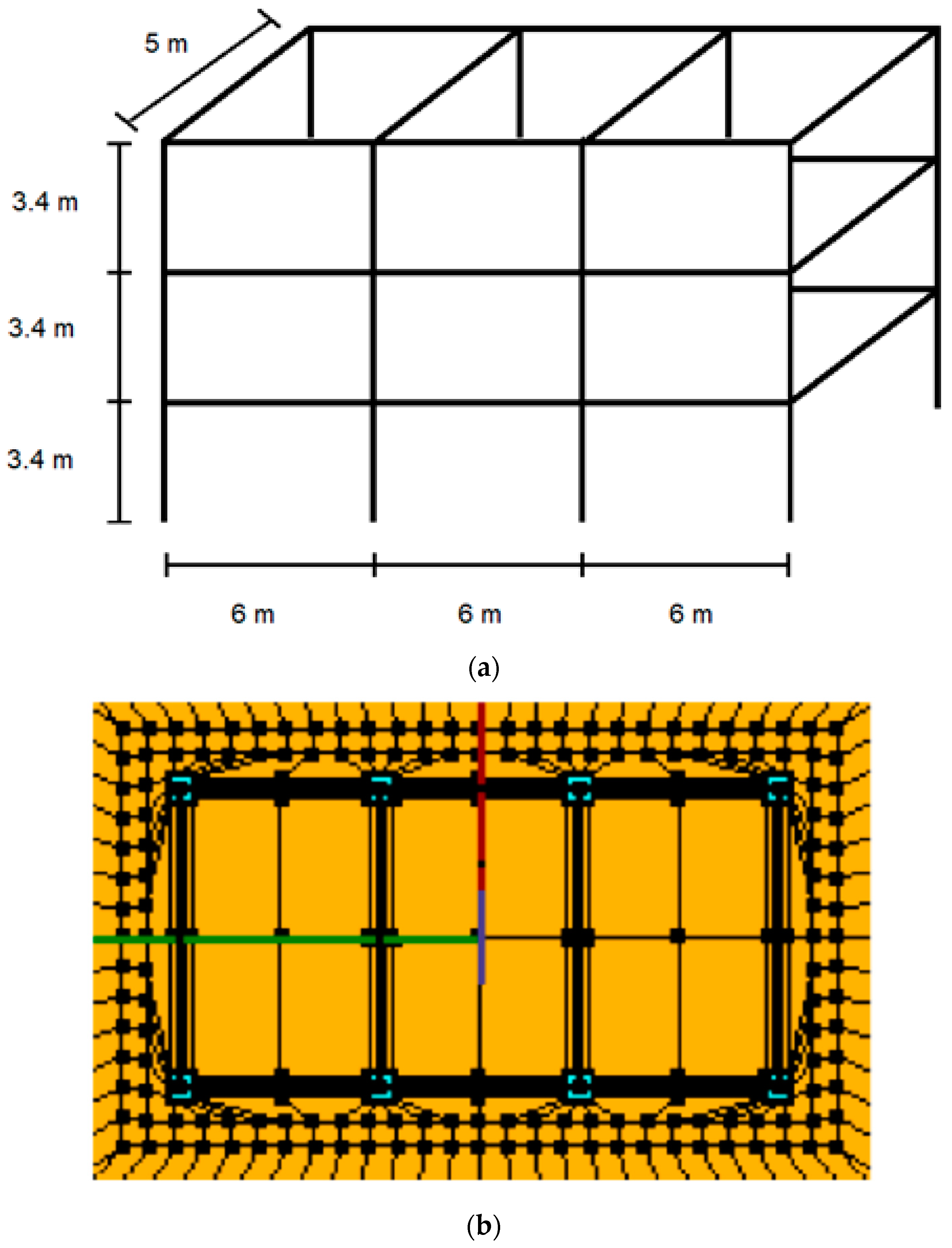
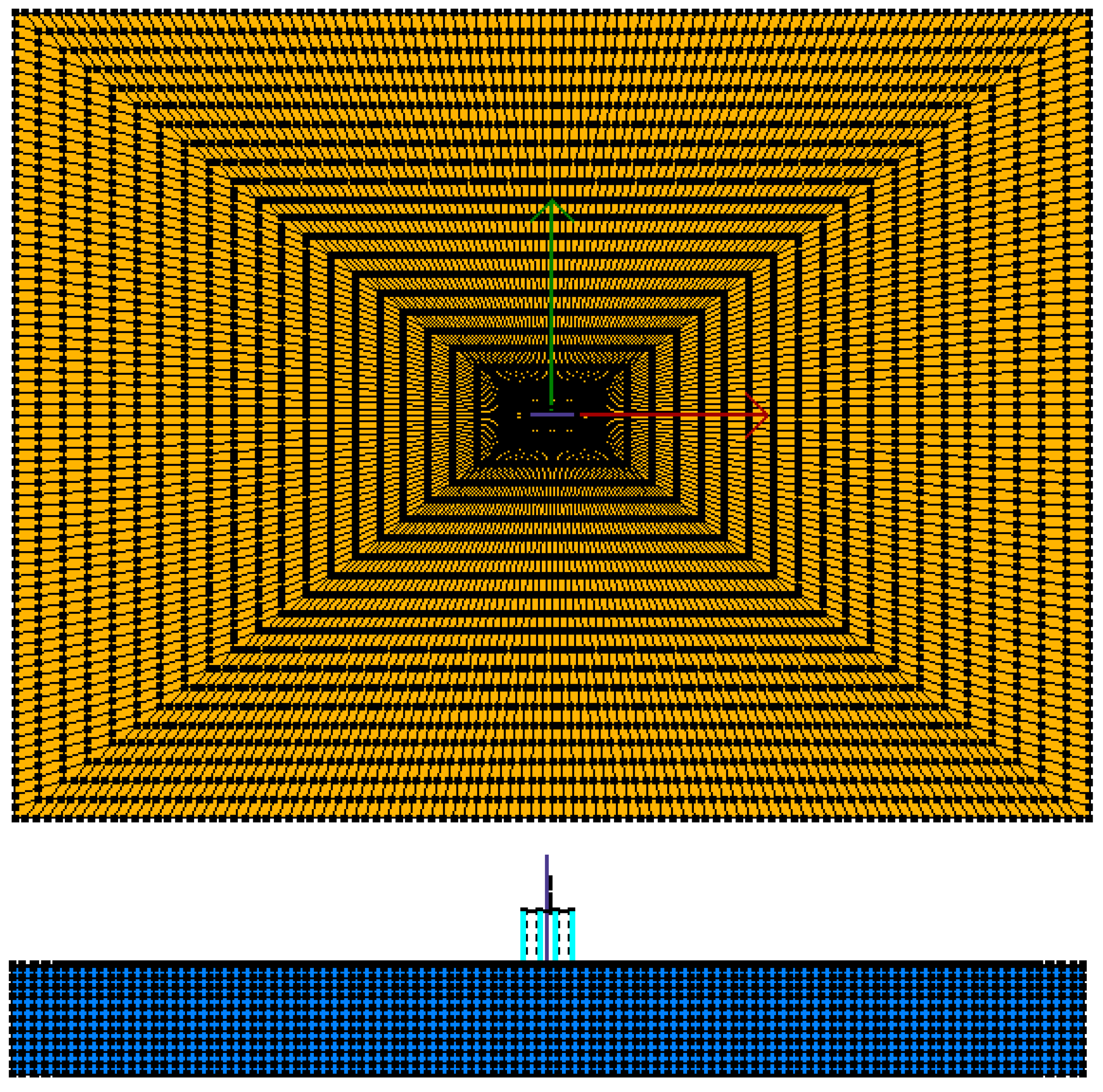

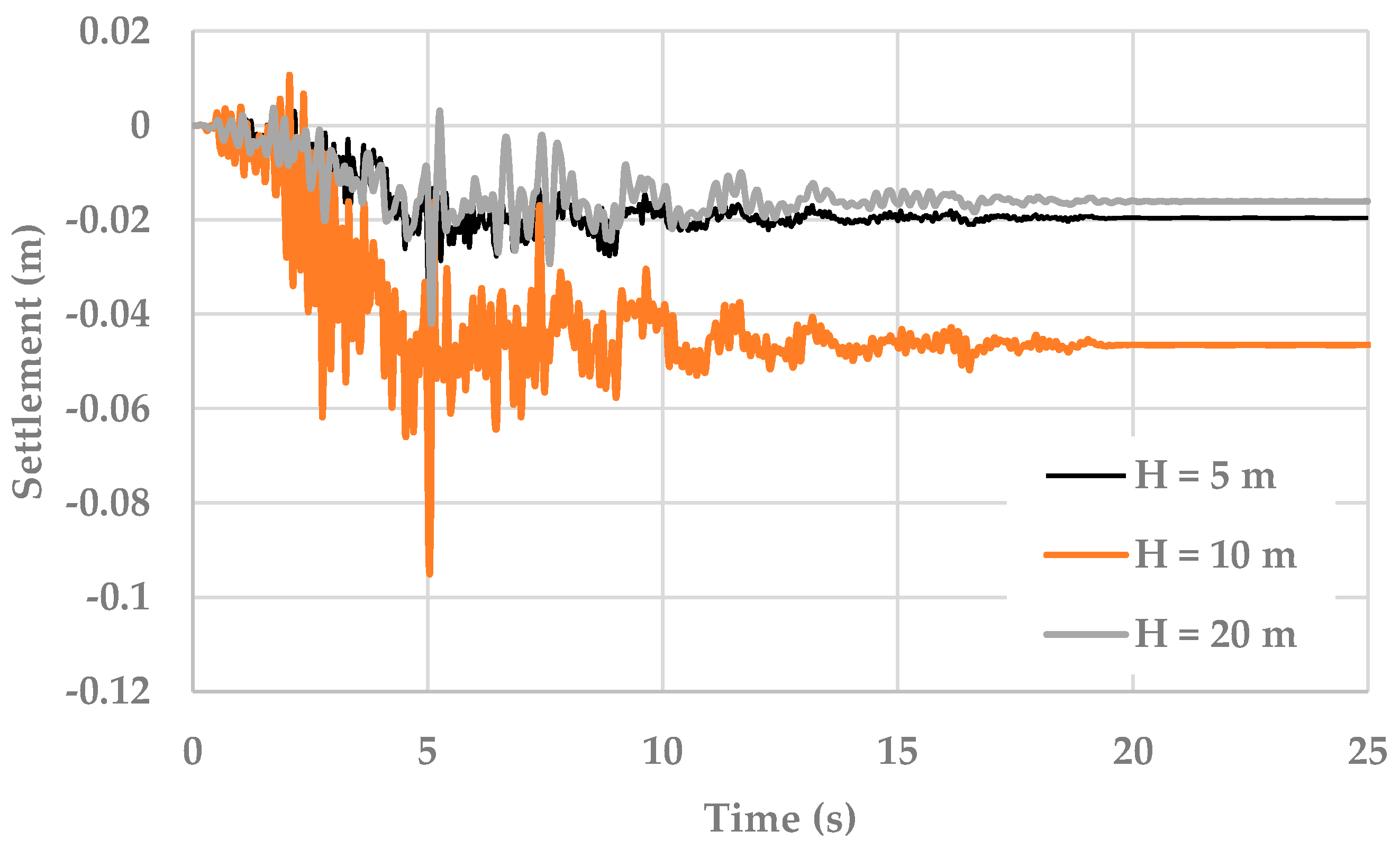
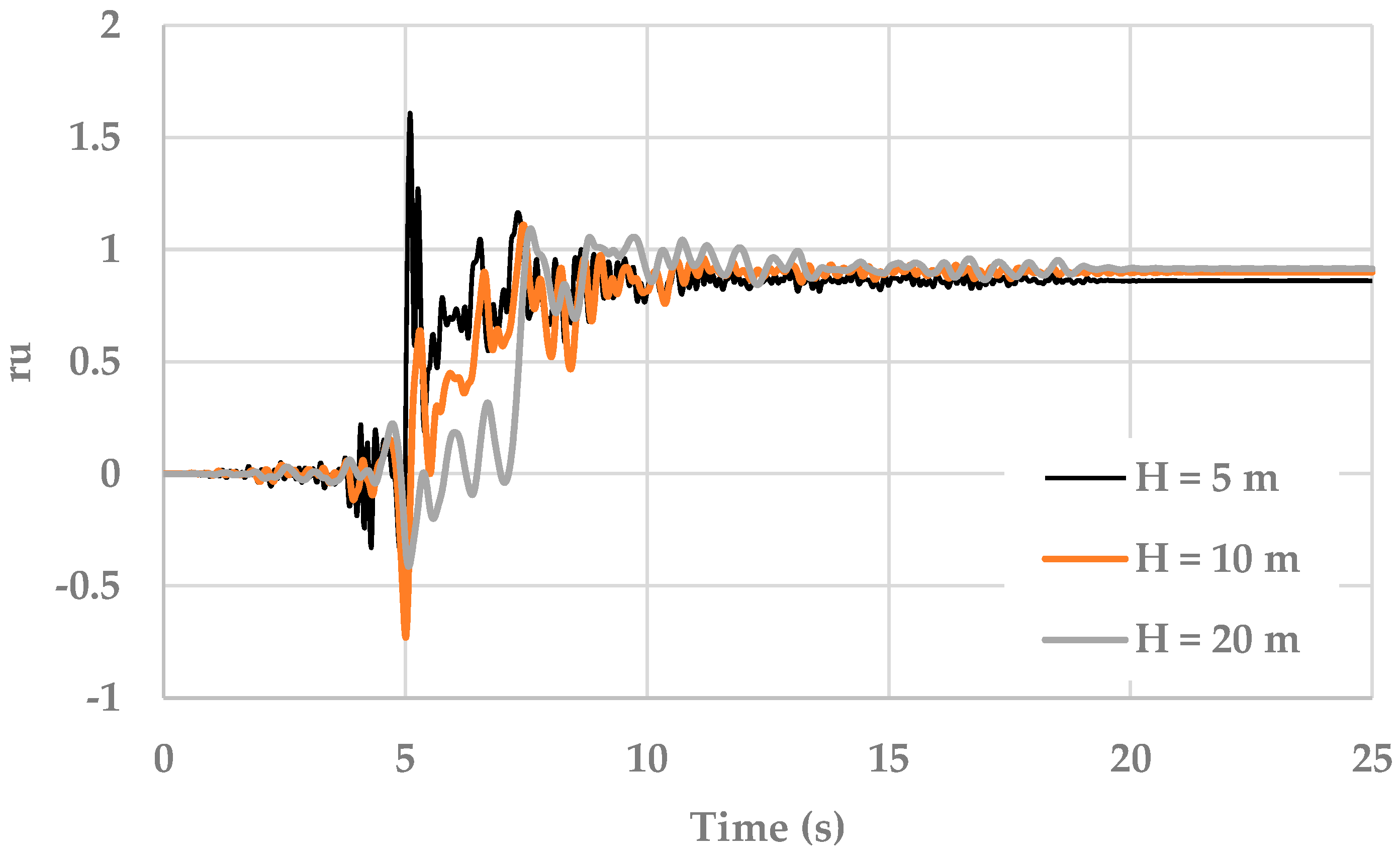
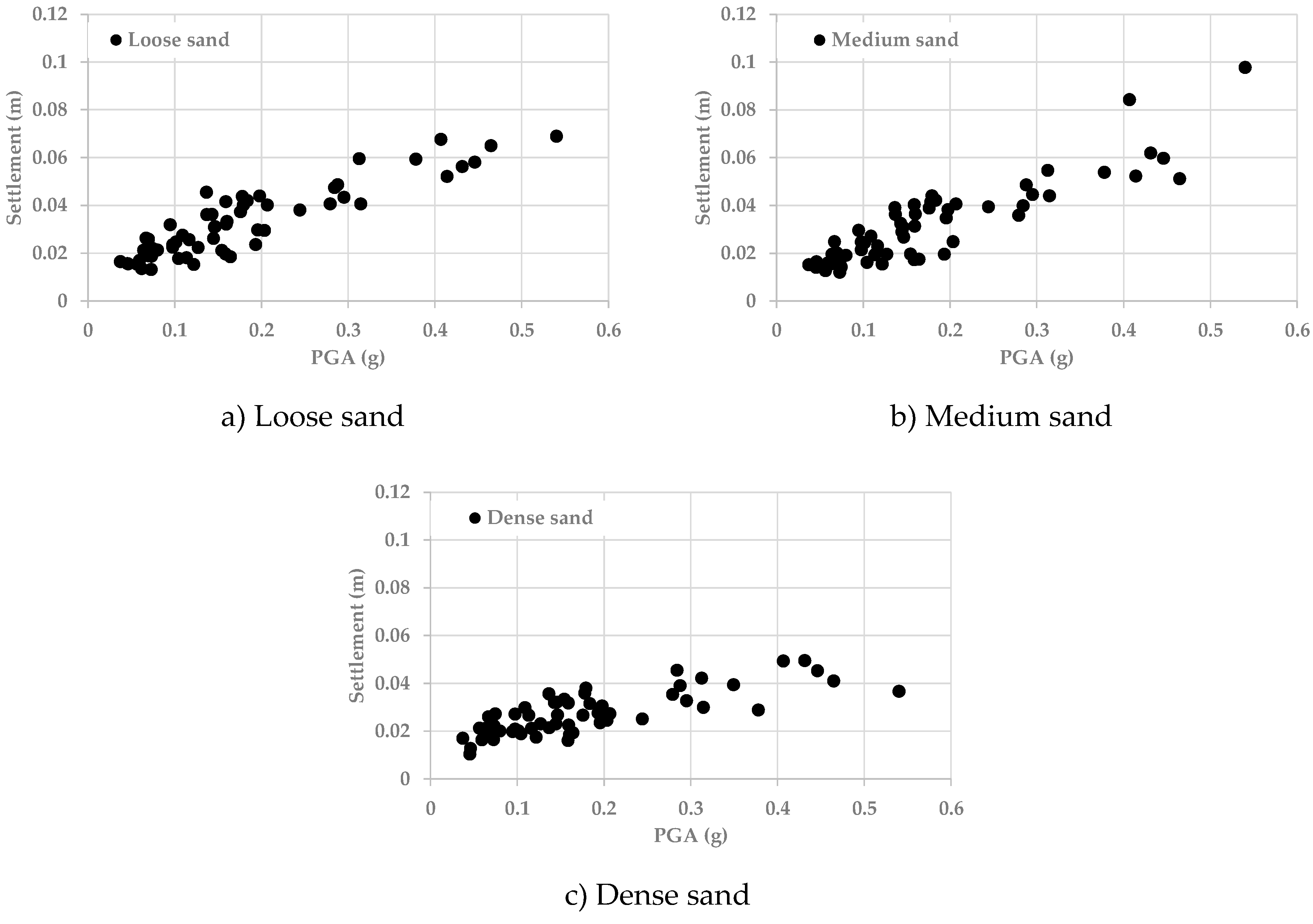

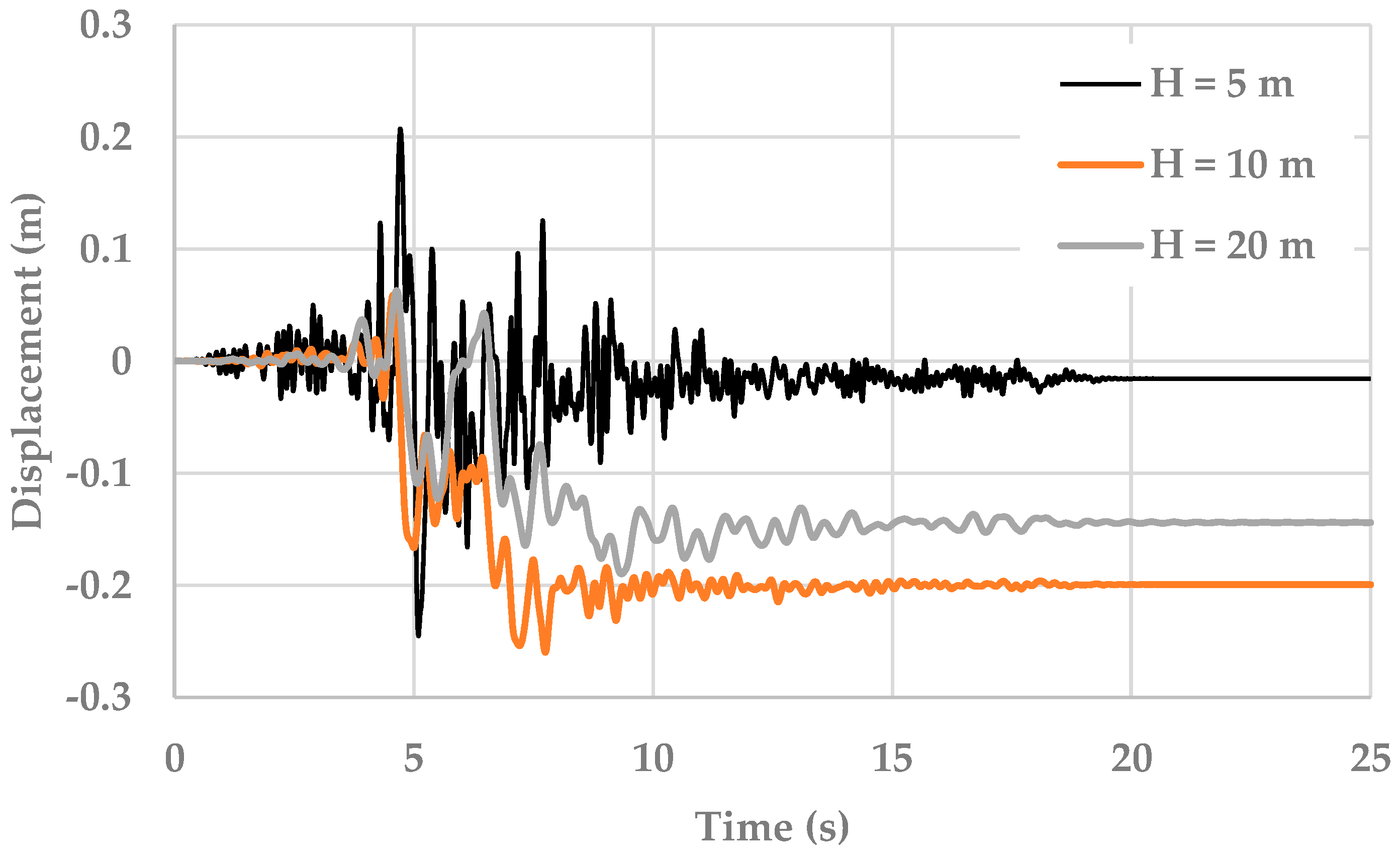
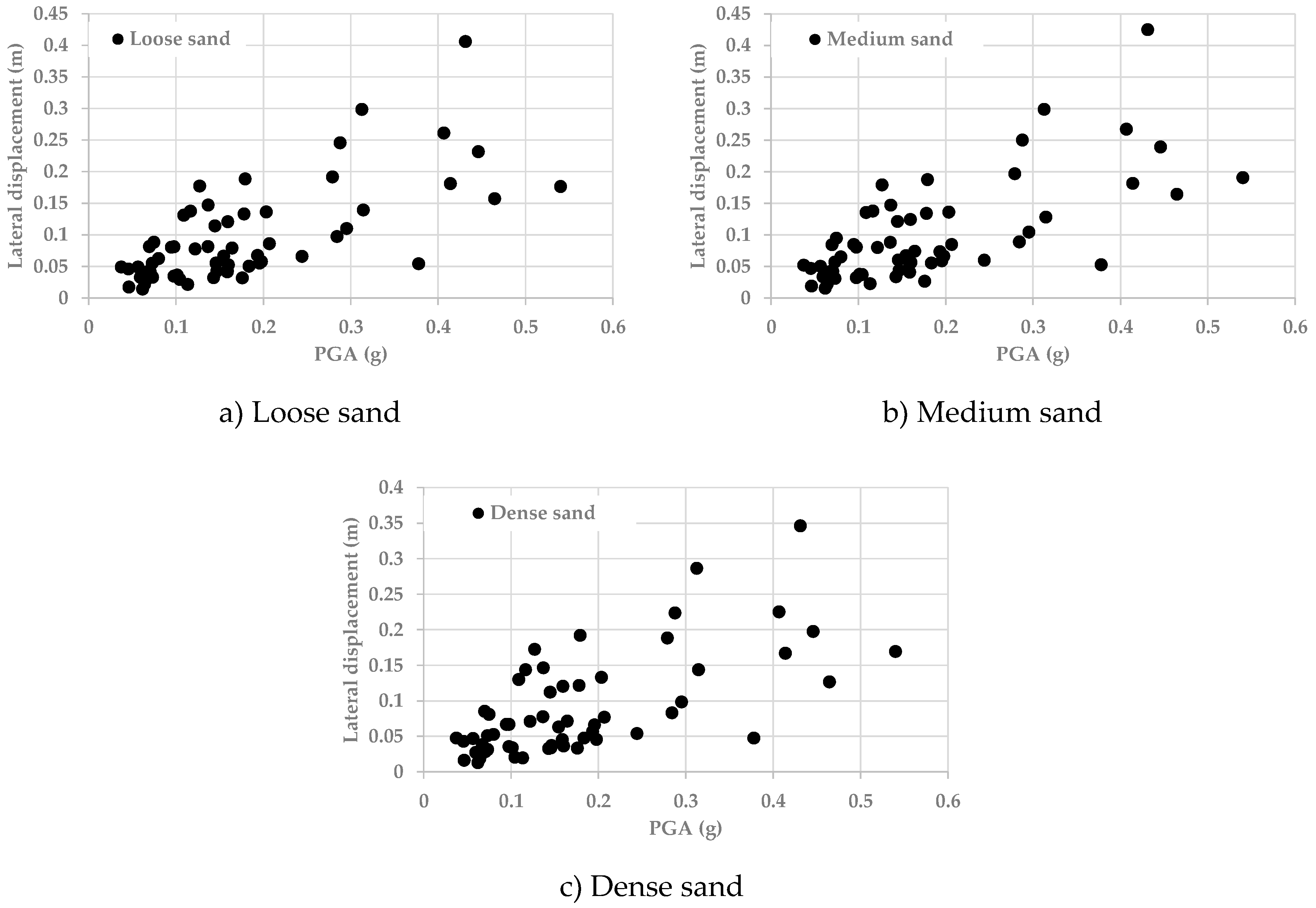
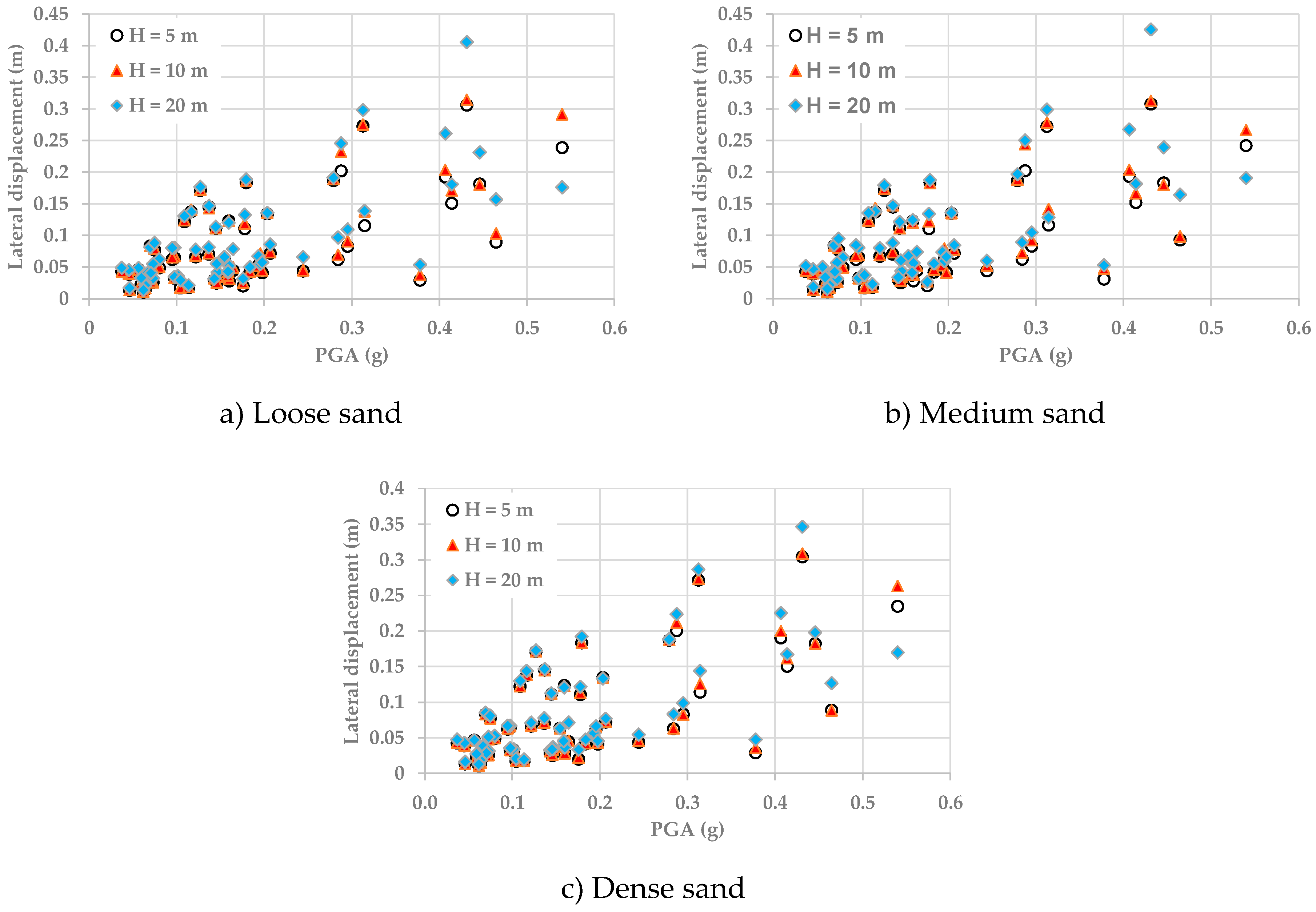
| No. | References | Type of Study | Soils Used | Story Height (m) | Building Height (m) | Foundation Length, Width, and Depth (m) | PGA (g) | Investigated Parameters |
|---|---|---|---|---|---|---|---|---|
| 1 | Dashti et al. [1] | Laboratory study using centrifuge | Loose sand (Dr = 30%) Medium sand (Dr = 50%) | N/P | 5 5 9.2 | 9.0 × 6.0 × N/A 18.0 × 12.0 × N/A 9 × 6 × N/A | 0.19 and 0.55 | - Thickness of the liquefiable layer - Relative density of the liquefiable layer |
| 2 | Karamitros et al. [2] | 2D FDM 3D FDM | Loose sand (Dr = 40%) Medium sand (Dr = 50%) Medium-dense sand (Dr = 60%) | * | * | XX ** × 5.0 × N/A 5.3 × 5.3 × N/A | 0.10–0.35 | - Load of the structure - Relative density of the soil - Thickness of the liquefiable layer - Thickness of the non-liquefiable layer |
| 3 | Karamitros et al. [3] | 2D FDM | Medium sand (Dr = 50%) | * | * | XX ** × 5.0 × N/A | 0.05–0.35 | - Thickness of the non-liquefiable layer - Shear strength of the non-liquefiable layer - Load of the structure |
| 4 | Karamitros et al. [4] | 2D FDM 3D FDM | Loose sand (Dr = 40%) Medium sand (Dr = 50%) Medium-dense sand (Dr = 60%) | * | * | XX ** × 5.0 × N/A 5.3 × 5.3 × N/A | 0.10–0.35 | - Thickness of the non-liquefiable layer - Shear strength of the non-liquefiable layer - Load of the structure |
| 5 | Bertalot and Brennan [5] | Laboratory study using centrifuge | Loose sand (Dr = 40%) | * | * | 2.8 × 2.8 × N/A | 3.50 | - Thickness of the liquefiable layer - Load of the structure |
| 6 | Dimitriadi et al. [6] | 2D FDM | Loose sand Medium sand Medium-dense sand | * | * | XX ** × (3.0–5.0) × N/A | 0.10–0.35 | - Thickness of the non-liquefiable layer - Shear strength of the non-liquefiable layer - Load of the structure - Width of the foundation |
| 7 | Dimitriadi et al. [7] | 2D FDM | Loose sand Medium sand Medium-dense sand | * | * | XX ** × (3.0–5.0) × N/A | 0.15–0.30 | - Thickness of the non-liquefiable (improved) layer - Width of the non-liquefiable (improved) layer |
| 8 | Alzabeebee [8] | AI application | Loose sand Medium sand Medium-dense sand Dense sand | *** | 2–16 | N/A × (6–12) × N/A | N/A | - Load of the structure - Thickness of the liquefiable layer - Width of the building |
| 9 | Chaloulos et al. [9] | 2D FDM | Loose sand (Dr = 40%) | 1-Story | 3.0 | XX ** × (0.2–0.7) × 0.5 | 0.06–0.17 | - Thickness of the liquefiable layer - Thickness of the non-liquefiable layer - Footing width - Embedment depth - Load of the structure |
| Medium-dense sand (Dr = 50%) | 2-Story | 5.1 | XX ** × (0.2–0.7) × 0.5 | |||||
| 10 | Forcellini [10] | 3D FEM | Medium-dense sand | 3.4 | 6.8 13.6 20.4 | XX ** × 7.4 × XX ** XX ** × 7.4 × XX ** XX ** × 7.4 × XX ** | 0.16 | - Height of the building - Weight of the building |
| 11 | Qi and Knappett [11] | Laboratory study using centrifuge | Medium-dense sand (Dr = 55 to 60%) | 3 | 6 | 3.6 × 3.6 × 0.5 3.6 × 3.6 × 0.7 | 0.43 | - Permeability of the soil |
| Parameter | Value |
|---|---|
| Mass density (kN/m3) | 24.0 |
| Reference shear modulus (kN/m2) | 1.25 × 107 |
| Reference bulk modulus (kN/m2) | 1.67 × 107 |
| Parameter | Value |
|---|---|
| Mass density (kN/m3) | 24.0 |
| Young modulus (kN/m2) | 3.50 × 107 |
| Shear modulus (kN/m2) | 1.73 × 107 |
| Cross area (m2) | 0.12 |
| Inertial moment (m4) | 9.0 × 10−4 |
| Number | Earthquake | Station | Duration (s) | CAV (cm/s) | PGA (g) |
|---|---|---|---|---|---|
| 1 | A-ELC | 1968 Borrego Mountain | 40.00 | 478 | 0.13 |
| 2 | A2E | 1989 Loma Prieta | 39.96 | 617 | 0.18 |
| 3 | FMS | 1989 Loma Prieta | 39.76 | 538 | 0.20 |
| 4 | HVR | 1989 Loma Prieta | 39.96 | 503 | 0.14 |
| 5 | SJW | 1989 Loma Prieta | 39.96 | 427 | 0.12 |
| 6 | BAD | 1994 Northridge | 35.00 | 323 | 0.10 |
| 7 | CAS | 1994 Northridge | 39.80 | 476 | 0.15 |
| 8 | DLE | 1994 Northridge | 35.36 | 594 | 0.14 |
| 9 | JAB | 1994 Northridge | 35.00 | 424 | 0.10 |
| 10 | L01 | 1994 Northridge | 32.00 | 361 | 0.09 |
| 11 | LOA | 1994 Northridge | 40.00 | 472 | 0.15 |
| 12 | LV2 | 1994 Northridge | 32.00 | 251 | 0.10 |
| 13 | PHP | 1994 Northridge | 60.00 | 340 | 0.08 |
| 14 | PIC | 1994 Northridge | 40.00 | 426 | 0.19 |
| 15 | SOR | 1994 Northridge | 36.48 | 278 | 0.07 |
| 16 | SSE | 1994 Northridge | 35.00 | 577 | 0.20 |
| 17 | VER | 1994 Northridge | 30.00 | 448 | 0.16 |
| 18 | AGW | 1989 Loma Prieta | 40.00 | 649 | 0.18 |
| 19 | G04 | 1989 Loma Prieta | 39.96 | 927 | 0.41 |
| 20 | CNP | 1994 Northridge | 25.00 | 1149 | 0.43 |
| 21 | FLE | 1994 Northridge | 30.00 | 607 | 0.28 |
| 22 | LOS | 1994 Northridge | 20.00 | 904 | 0.54 |
| 23 | RO3 | 1994 Northridge | 30.28 | 1004 | 0.45 |
| 24 | H-CXO | 1979 Imperial Valley | 37.82 | 791 | 0.28 |
| 25 | H-SHP | 1979 Imperial Valley | 15.72 | 708 | 0.46 |
| 26 | I-ELC | 1979 Imperial Valley | 40.00 | 1311 | 0.31 |
| 27 | G02 | 1989 Loma Prieta | 39.96 | 817 | 0.41 |
| 28 | GOF | 1989 Loma Prieta | 39.96 | 626 | 0.30 |
| 29 | Z-HVR | 1984 Morgan Hill | 39.98 | 598 | 0.31 |
| 30 | B-ELC | 1968 Borrego Mountain | 40.00 | 331 | 0.07 |
| 31 | H-C05 | 1983 Coalinga | 40.00 | 432 | 0.16 |
| 32 | H-C08 | 1983 Coalinga | 32.00 | 384 | 0.10 |
| 33 | H-CC4 | 1979 Imperial Valley | 28.54 | 264 | 0.16 |
| 34 | H-CMP | 1979 Imperial Valley | 36.00 | 614 | 0.21 |
| 35 | H-NIL | 1979 Imperial Valley | 40.00 | 419 | 0.11 |
| 36 | H-PLS | 1979 Imperial Valley | 18.76 | 131 | 0.06 |
| 37 | A-STP | 1980 Livermore | 33.00 | 249 | 0.07 |
| 38 | SJB | 1984 Morgan Hill | 28.00 | 162 | 0.05 |
| 39 | Z-CAP | 1984 Morgan Hill | 36.00 | 360 | 0.14 |
| 40 | Z-HCH | 1984 Morgan Hill | 28.34 | 341 | 0.07 |
| 41 | H06 | 1986 North Palm Springs | 40.00 | 218 | 0.07 |
| 42 | INO | 1986 North Palm Springs | 30.00 | 254 | 0.12 |
| 43 | A-CTS | 1987 Whittier Narrows | 39.96 | 218 | 0.06 |
| 44 | A-HAR | 1987 Whittier Narrows | 40.00 | 291 | 0.07 |
| 45 | A-SSE | 1987 Whittier Narrows | 22.94 | 219 | 0.05 |
| 46 | A-STC | 1987 Whittier Narrows | 40.00 | 431 | 0.18 |
| 47 | H-CAL | 1979 Imperial Valley | 39.54 | 391 | 0.14 |
| 48 | H-CHI | 1979 Imperial Valley | 40.00 | 1102 | 0.29 |
| 49 | H-E01 | 1979 Imperial Valley | 39.04 | 480 | 0.16 |
| 50 | A-KOD | 1980 Livermore | 20.98 | 325 | 0.16 |
| 51 | A-SRM | 1980 Livermore | 40.00 | 220 | 0.06 |
| 52 | Z-AGW | 1984 Morgan Hill | 29.98 | 290 | 0.04 |
| 53 | Z-GMR | 1984 Morgan Hill | 29.98 | 394 | 0.18 |
| 54 | PHN | 1935 Port Hueneme | 28.42 | 243 | 0.11 |
| 55 | A-CAS | 1987 Whittier Narrows | 21.18 | 546 | 0.38 |
| 56 | A-CAT | 1987 Whittier Narrows | 32.92 | 203 | 0.06 |
| 57 | A-DWN | 1987 Whittier Narrows | 40.00 | 470 | 0.24 |
| 58 | A-W70 | 1987 Whittier Narrows | 31.94 | 430 | 0.20 |
| Indicator | Duration (s) | CAV (cm/s) | PGA (g) |
|---|---|---|---|
| Minimum value | 15.72 | 131.00 | 0.04 |
| Maximum value | 60.00 | 1311.00 | 0.54 |
| Standard deviation | 7.41 | 255.36 | 0.12 |
| Average | 34.77 | 483.38 | 0.18 |
| Parameter | Loose Sand | Medium Sand * | Dense Sand ** |
|---|---|---|---|
| Density γ (kN/m3) *** | 16 | 18 | 20 |
| Low-strain shear modulus (G) (at 80 kPa mean effective confinement) (MPa) | 33 | 80 | 135 |
| Cohesion c’ (kPa) | 0 | 0 | 0 |
| Friction Angle ø’ (°) | 31.0 | 35.5 | 40 |
| Liquefaction yield strain (γy) (%) | 1.5 | 0.0 | 0.0 |
| Contraction parameter (c1) | 0.17 | 0.10 | 0.10 |
| Contraction parameter (c2) | 0.05 | 0.05 | 0.05 |
| Phase transformation angle (øPT) | 26.5 | 26.5 | 26.0 |
| Dilation parameter (d1) | 0.4 | 0.8 | 0.80 |
| Dilation parameter (d2) | 10 | 10 | 5.0 |
Publisher’s Note: MDPI stays neutral with regard to jurisdictional claims in published maps and institutional affiliations. |
© 2021 by the authors. Licensee MDPI, Basel, Switzerland. This article is an open access article distributed under the terms and conditions of the Creative Commons Attribution (CC BY) license (https://creativecommons.org/licenses/by/4.0/).
Share and Cite
Alzabeebee, S.; Forcellini, D. Numerical Simulations of the Seismic Response of a RC Structure Resting on Liquefiable Soil. Buildings 2021, 11, 379. https://doi.org/10.3390/buildings11090379
Alzabeebee S, Forcellini D. Numerical Simulations of the Seismic Response of a RC Structure Resting on Liquefiable Soil. Buildings. 2021; 11(9):379. https://doi.org/10.3390/buildings11090379
Chicago/Turabian StyleAlzabeebee, Saif, and Davide Forcellini. 2021. "Numerical Simulations of the Seismic Response of a RC Structure Resting on Liquefiable Soil" Buildings 11, no. 9: 379. https://doi.org/10.3390/buildings11090379
APA StyleAlzabeebee, S., & Forcellini, D. (2021). Numerical Simulations of the Seismic Response of a RC Structure Resting on Liquefiable Soil. Buildings, 11(9), 379. https://doi.org/10.3390/buildings11090379







